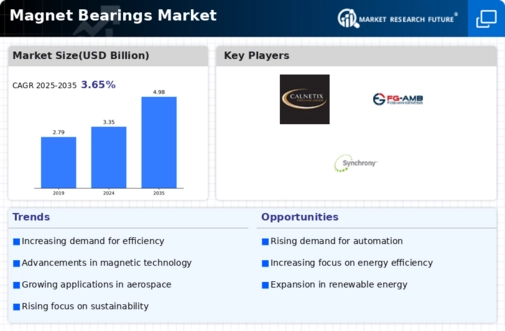Top Industry Leaders in the Magnet Bearings Market

*Disclaimer: List of key companies in no particular order
Top listed global companies in the industry are:
- Calnetix Technologies
- Siemens AG
- Waukesha Bearings Corporation
- Mecos AG
- Foshan Genesis
- Synchrony
- SKF AB
- Celeroton AG, and others.
Navigating the Magnetic Maze: Competitive Landscape of the Magnet Bearings Market
The global magnet bearings is a dynamic arena where established players and innovative startups compete for traction. Understanding the forces driving this competition, the factors influencing market share, and emerging trends is crucial for navigating this high-performance landscape.
Key Players and their Strategies:
- Global Behemoths: Giants like SKF and Schaeffler leverage their extensive R&D capabilities, diverse product portfolios, and established distribution networks to hold a significant market share. SKF offers customized solutions for various industries, while Schaeffler focuses on high-speed applications.
- Regional Specialists: Companies like Nidec Corporation and China Aerospace Science and Technology Corporation dominate specific geographies by tailoring solutions to regional regulations and industry needs. Nidec caters to Japan's advanced technology sector, while CASC excels in meeting China's aerospace demands.
- Technology Trailblazers: Startups like Active Magnetic Bearings Inc. and Magnetic Innovations Inc. disrupt the market with cutting-edge approaches. AMB focuses on high-temperature superconducting bearings for extreme environments, while Magnetic Innovations pushes the boundaries of miniaturization for medical applications.
Factors for Market Share Analysis:
- Technology Leadership: Offering advanced bearing designs, materials like rare-earth magnets, and active control systems for superior performance and efficiency attracts key customers. AMB's high-temperature bearings exemplify this.
- Industry Expertise: Deep understanding of specific industries (oil & gas, aerospace, medical) and their bearing requirements allows players to develop tailored solutions for optimal performance and reliability. Nidec's expertise in turbomachinery exemplifies this.
- Cost-Effectiveness and ROI: Balancing advanced features with affordability is crucial, especially in budget-conscious segments. CASC's cost-competitive bearings have secured a strong foothold in emerging markets.
- After-Sales Service and Support: Providing comprehensive after-sales support, including monitoring, predictive maintenance, and spare parts, fosters customer loyalty and market penetration. SKF excels in this area with its extensive service network.
Emerging Trends and Company Strategies:
- Focus on Sustainability: Utilizing eco-friendly materials, reducing energy consumption, and offering lifecycle support for reduced waste are gaining traction. Magnetic Innovations' recyclable bearings exemplify this trend.
- Integration with Digital Solutions: Incorporating sensor technology and connectivity into bearings enables real-time performance monitoring, predictive maintenance, and data-driven optimization. Schaeffler's sensor-integrated bearings illustrate this trend.
- Miniaturization and Specialization: Developing bearings for compact applications like medical devices and robotics opens up new market segments. Magnetic Innovations' micro-bearings for medical robotics exemplify this.
- Focus on High-Growth Sectors: Targeting industries like electric vehicles, wind turbines, and high-speed trains with specialized bearing solutions creates new growth opportunities. Nidec's traction motor bearings for EVs illustrate this approach.
Overall Competitive Scenario:
The magnet bearings market presents a dynamic landscape where global giants battle it out with regional players and technology-driven startups. Success hinges on continuous innovation, industry expertise, offering cost-effective solutions, and adaptability to emerging trends like sustainability and digitalization. Companies demonstrating agility, customer service, and a focus on specific market segments hold a strong pole position in this magnetic marketplace.
Latest Company Updates:
August 2023- The latest project video from Carl Bugeja cleverly combines several techniques to create electrically actuated flexure bearings using materials and processes available from PCB vendors. A flexure bearing is a part with two rigid structures joined by a thin area that acts as a hinge. For example, think of a container with an attached plastic lid that snaps shut. Bugeja combined that idea with flexible PCB actuators to produce an electrically controlled bearing that deforms to generate motion. As with previous projects, the video documents the initial design idea, several variations, and the need for iterations. Initially, Bugeja made five different flexure designs. A PCB fab manufactured the bearing frame, flexure hinge, and adhesive. The only material Bugeja had to add was the magnet. Several designs, like the spring style, were too fragile to be reliably assembled or used. However, what Bugeja calls the "zig-zag design" performed the best of the 40 variations tested, which leads to the question of what such a device could do. Bugeja explored five potential applications for the flexure bearing. The most practical option is a sound generation device, which is unsurprising since the entire structure resembles a speaker. The most eye-catching attempt was a pop-up display that emulates a seven-segment display. Unfortunately, Bugeja encountered problems installing the magnets, so the video does not show an entire digit as functional. Instead, only two elements were loaded. Even more unfortunate, the result was not a flipping mechanism.

